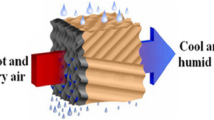Abstract
Performance of two-stage evaporative coolers at various outdoor air conditions was numerically studied, and its geometric and physical characteristics were obtained based on thermal comfort criteria. For this purpose, a mathematical model was developed based on conservation equations of mass, momentum and energy to determine heat and mass transfer characteristics of the system. The results showed that two-stage indirect/direct cooler can provide the thermal comfort condition when outdoor air temperature and relative humidity are located in the range of 34–54 °C and 10–60 %, respectively. Moreover, as relative humidity of the ambient air rises, two-stage evaporative cooler with the smaller direct and larger indirect cooler will be needed. In building with high cooling demand, thermal comfort may be achieved at a greater air change per hour number, and thus an expensive two-stage evaporative cooler with a higher electricity consumption would be required. Finally, a design guideline was proposed to determine the size of required plate heat exchangers at various operating conditions.










Similar content being viewed by others
Abbreviations
- b:
-
Width of wall (m)
- C p :
-
Specific heat at constant pressure (J/kg K)
- C pv :
-
Specific heat of water vapour at constant pressure (J/kg K)
- d :
-
Mean pitch of the air channel in a pad (m)
- f :
-
Wettability factor
- g :
-
Gravitational acceleration (m/s2)
- H :
-
Specific enthalpy (kJ/kg)
- H fg :
-
Latent heat of water (kJ/kg)
- Le :
-
Lewis factor
- h c :
-
Convective heat transfer coefficient (W/m2 K)
- h m :
-
Mass transfer coefficient (W/m2 s)
- k :
-
Thermal conductivity (W/m K)
- k a :
-
Volumetric mass transfer coefficient based on unit humidity ratio difference (kg/m3)
- L:
-
Height of channel (m)
- Le:
-
Lewis number
- m :
-
Mass flow rate (kg/s)
- m v :
-
Mass source term (kg/m3 s)
- p:
-
Pressure (Pa)
- q v :
-
Heat source term (W/m3)
- T :
-
Air temperature (K)
- U :
-
Overall heat transfer coefficient (W/m2 K)
- u :
-
Air flow velocity in x direction (m/s)
- V :
-
Volume (m3)
- v :
-
Air flow velocity in y direction (m/s)
- w :
-
Air flow velocity in z direction (m/s)
- x, y, z :
-
Coordinate system (m)
- Γeff :
-
Effective thermal diffusion coefficient of air (kg/m s)
- ηeff :
-
Effective dynamic viscosity of air (kg/m s)
- δ:
-
Thickness of water film (m)
- ε:
-
Cooling effectiveness
- μ:
-
Dynamic viscosity (kg/s m)
- ν:
-
Kinematic viscosity (m2/s)
- ρ:
-
Density (kg/m3)
- ω:
-
Humidity ratio (kg water vapor/kg dry air)
- Re:
-
Reynolds number (ufdhyd/νf)
- a :
-
Ambient air
- db :
-
Dry bulb
- f :
-
Air stream
- in :
-
Inlet
- IEC :
-
Indirect evaporative cooler
- out :
-
Outlet
- p :
-
Primary
- pw :
-
Water vapor
- r :
-
Room
- s :
-
Secondary
- w :
-
Water stream
- wb :
-
Wet bulb
References
Watt JR, Brown WK (1997) Evaporative air conditioning handbook. Fairmont Press, Lilburn, GA
Scofield CM, DesChamps NH (1984) Indirect evaporative cooling using plate type heat exchangers. ASHRAE Trans 90:148–153
Al-Juwayhel FI, Al-Haddad AA, Shaban HI, El-Dessouky HT (1997) Experimental investigation of performance of two-stage evaporative cooler. Heat Transf Eng 18:21–33
El-Dessouky HTA, Al-Haddad AA (1996) Thermal and hydraulic performance of a modified two-stage evaporative cooler. Renew Energy 7:165–176
El-Dessouky H, Ettouney H, Al-Zeefari A (2004) Performance analysis of two-stage evaporative coolers. Chem Eng J 102:255–266
Jain D (2007) Development and testing of two-stage evaporative cooler. Build Environ 42:2549–2554
Heidarinejad G, Bozorgmehr M, Delfani S, Esmaeelian H (2009) Experimental investigation of two-stage indirect/direct evaporative cooling system in various climatic conditions. Build Environ 44:2073–2079
ISO-7730 (1993) Moderate thermal environment—Determination of PMV and PPD indices and specifications of the conditions of thermal comfort. International Standard Organization, Geneva
Heidarinejad G, Khlajzadeh V, Delfani S (2010) Performance analysis of a ground-assisted direct evaporative cooling air conditioner. Build Environ 45:2421–2429
Wu JM, Huang X, Zhang H (2009) Numerical investigation on the heat and mass transfer in a direct evaporative cooler. Appl Therm Eng 29:195–201
Haghighi AP, Gilani N, Moharrer MM (2009) Investigation on the effects of flow direction and characteristics of direct evaporative cooler on thermal performance. In: 6th international chemical engineering congress and exhibition, Kish Island, Iran
Guo XC, Zhao TS (1998) A parametric study of an indirect evaporative air cooler. Heat Mass Transf 25:217–226
Shariaty-Niassar M, Gilani N (2009) An investigation of indirect evaporative coolers with respect to thermal comfort criteria. Iran J Chem Eng 6:14–28
Erens PJ, Dreyer AA (1993) Modeling of indirect evaporative coolers. Int J Heat Mass Transf 36:17–26
San Jose Alonso JF, Rey Martinez FJ, Velasco Gomes E, Alvarez-Guerra Plasencia MA (1998) Simulation model of an indirect evaporative cooler. Energ Build 29:23–27
Dai YJ, Sumathy K (2002) Theoretical study on a cross-flow direct evaporative cooler using honeycomb paper as packing material. Appl Therm Eng 22:1417–1430
Acknowledgments
The authors would like to acknowledge College of Engineering, University of Tehran and Iran National science Foundation (INSF) for the esteemed financial support.
Author information
Authors and Affiliations
Corresponding author
Rights and permissions
About this article
Cite this article
Gilani, N., Poshtiri, A.H. Thermal design of two-stage evaporative cooler based on thermal comfort criterion. Heat Mass Transfer 53, 1355–1374 (2017). https://doi.org/10.1007/s00231-016-1889-z
Received:
Accepted:
Published:
Issue Date:
DOI: https://doi.org/10.1007/s00231-016-1889-z




